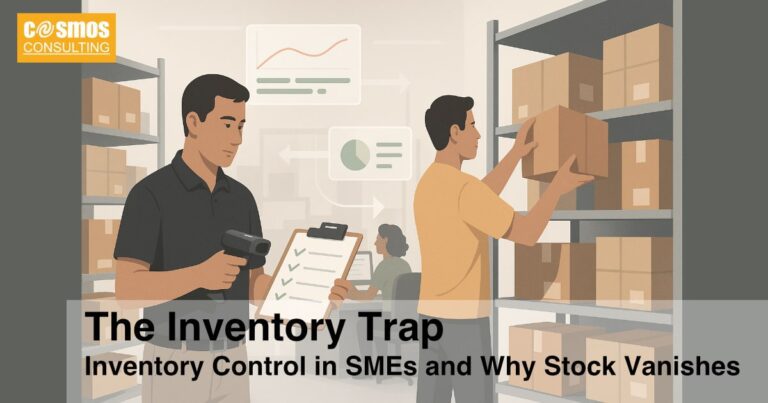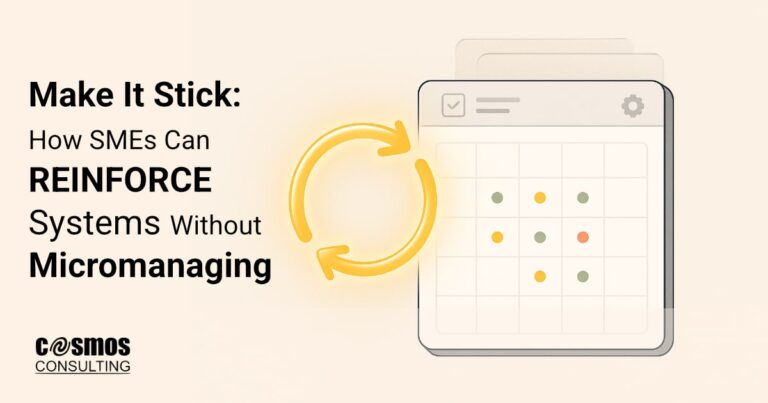🧭 Introduction: Systems Can’t Scale If Leadership Stalls
💡 This blog introduces the COSMOS 5R Leadership Framework™; a practical approach to leading systems without doing everything yourself.
Even the best systems break down if leadership doesn’t evolve.
We have seen it too often: SOPs are written, tools are in place, but the founder is still approving every task, chasing updates, or redoing work late at night.
That is because most SMEs don’t just have an operations gap.
They have a leadership bottleneck.
The COSMOS 5R SME Leadership Framework™ is Cosmos Consulting’s reset method for founders who have built solid systems but still feel stuck in day-to-day firefighting.
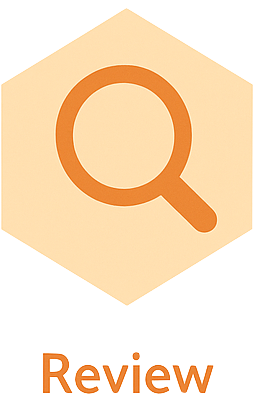
Step back and assess what’s broken

Turn fixes into documented process
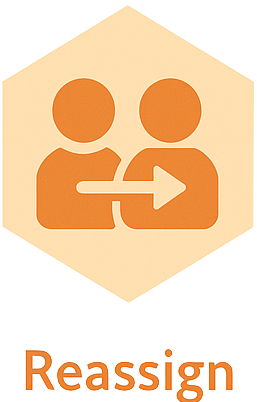
Shift clear ownership to the right roles

Create visibility without micromanaging

Make it stick with habits, not hope
It is a practical path to shift from reactive decision-making to proactive leadership; not by adding more tasks, but by resetting how you manage clarity, ownership, and accountability across the team.
If the COSMOS 4S Systems Framework™ helps you build scalable systems, the 5R Framework helps you lead them; without becoming the system yourself.
Because leadership is not just about vision. It is about follow-through, visibility, and team alignment. And without it, even the best systems stagnate.
🧠 What Is the COSMOS 5R SME Leadership Framework™?
The COSMOS 5R Framework is Cosmos Consulting’s method for helping founders lead systems, instead of being trapped inside them.
It was developed for SMEs that already have some structure, SOPs, and tools in place… but still feel like nothing moves without the founder’s push.
The COSMOS 5R Framework is a leadership reset – five shifts that help you:
- step back without losing control,
- create alignment across the team, and
- drive progress through rhythm, not reaction.
“Leadership is not just about knowing what to do — it’s about making sure it gets done without you needing to do it all.”
Each “R” is designed to fix a breakdown we see repeatedly in founder-led teams:
- Review what is stuck
- Record what should happen instead
- Reassign roles with clarity
- Report progress regularly
- Reinforce what works consistently
When used together, these steps help you scale your leadership, not just your systems. Each step exists because skipping it weakens execution.
🎯 Still stuck in daily firefighting?

Step 1: Review — Clarity Starts With Truth
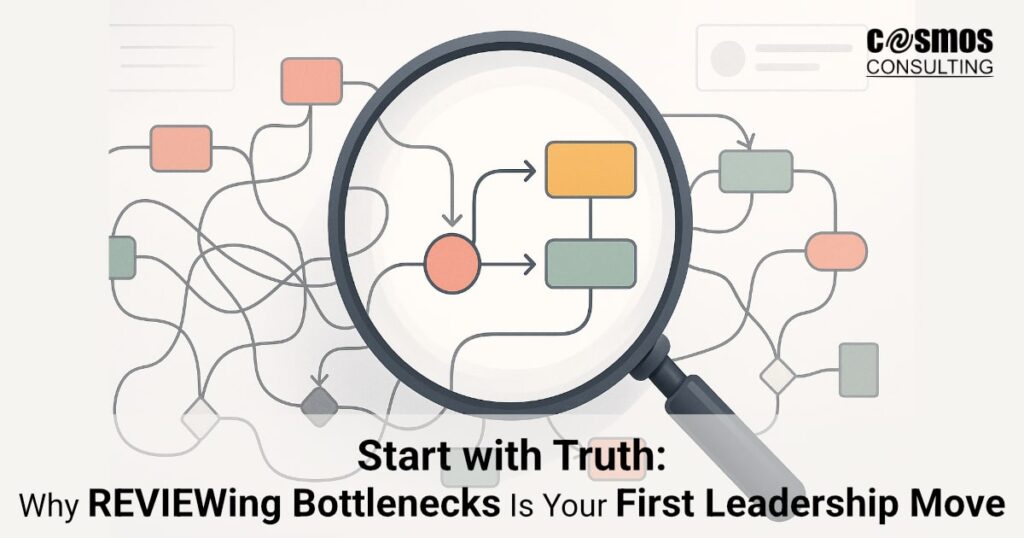
Every leadership reset starts by looking honestly at where things are stuck.
This “R” earned its place in the 5R Framework because most SME founders don’t realise how many hidden bottlenecks depend on them; until something goes wrong.
“Review” doesn’t mean auditing people. It means reviewing the actual flow of work:
- What do you still get pulled into, even after delegating it?
- Where do tasks stall?
- What decisions always land back on your desk?
🟡 Example: A sales handover SOP might exist, but if the ops team constantly asks the founder to confirm delivery timelines, the real bottleneck isn’t the SOP. It is the lack of cross-team clarity or role ownership.
Review is where truth surfaces. And clarity begins.
👉 Read the deep dive: Start With Truth: Why Reviewing Bottlenecks Is Your First Leadership Move

Step 2: Record — Capture What Should Happen Instead
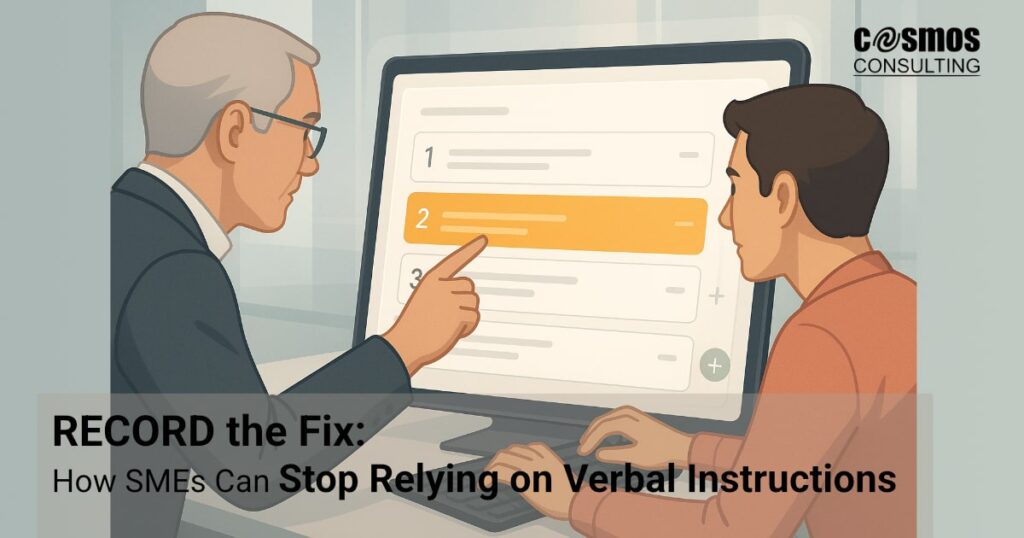
Once you have identified what is breaking down, the next move is to capture what should happen instead, clearly and specifically.
This “R” earned its place in the framework because without written clarity, most delegation becomes guesswork, and blame follows.
“Record” here doesn’t mean writing full SOPs. That’s part of your 4S Systems Foundation. This is about recording expectations:
- What should trigger a follow-up, and how is it reported?
- What outcome is expected?
- Who does what, by when?
🟡 Example: If your ops lead owns client delivery, record what “ownership” means then you need to ask: is it just execution, or does it include client updates, problem-solving, and handover to accounts?
When these definitions are vague, everyone assumes something different and no one feels truly responsible.
Recording clears the fog.
👉 Read the deep dive: Record the Fix: How SMEs Can Stop Relying on Verbal Instructions

Step 3: Reassign – Delegation That Doesn’t Backfire
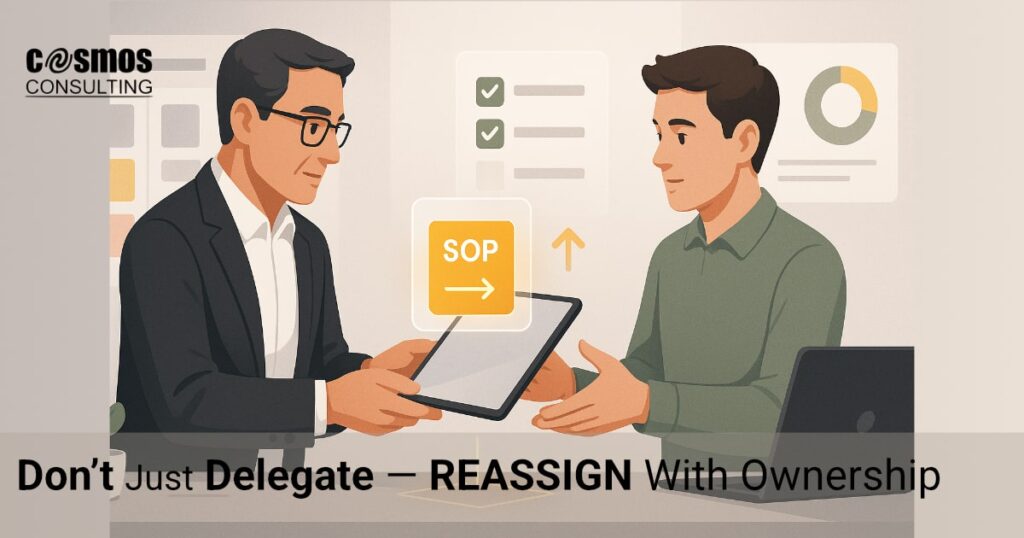
Delegation isn’t just about handing something off. It is about reassigning ownership with clarity, accountability, and support.
This “R” earned its place because so many SME leaders delegate reactively: during a crisis, without clear direction and then end up taking the task back.
That’s not failed delegation. That’s missing structure.
Once you have reviewed what’s broken and recorded what should happen, you can reassign roles in a way that actually works. That means:
- Giving people space and backup.
- Defining what success looks like.
- Clarifying boundaries and authority.
Reassignment is often the tipping point for a culture shift. This is where many SME leaders hesitate. Delegation feels risky and re-entry feels worse.
But clarity reduces risk.
The article Why Aren’t You Delegating? offers a striking look at why most leaders resist this shift.
This step helps leaders begin trusting their teams, even if the system is not perfect. Because DONE is better than dependent. It is a pivotal moment in any SME leadership journey because ownership drives execution.
🟡 Example: Telling your finance assistant to “handle payments” is vague. But assigning them ownership of vendor payouts by Friday each week, with SOP support and a reporting loop; that’s effective delegation.
Reassignment is not abdication. It is designed.
👉 Read the deep dive: Don’t Just Delegate; Reassign With Ownership

📊 Step 4: Report — Visibility That Drives Accountability
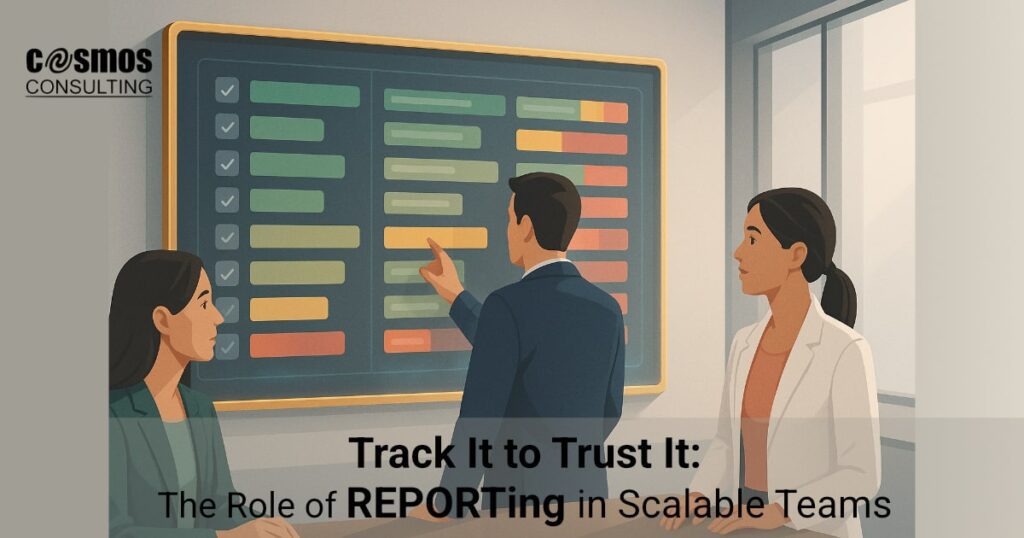
This step matters because what is not tracked quickly fades. Even the best-documented, clearly reassigned task can fall through the cracks if there is no visibility on whether it is being done.
Reporting is not about micromanaging. It is about creating shared visibility, so that everyone knows what is on track, what is delayed, and where support is needed.
Good reporting does not overwhelm. It surfaces signals, not noise. And when it is built into the workflow (not as a side process), it becomes a habit, not a burden.
And here is the real leadership move: knowing what to track. It takes experience and judgment to identify the few key reporting points that give teams autonomy and give leaders peace of mind. That is why reporting is more art than admin.
It builds accountability across the board and allows leaders to step back without losing visibility, while still staying on top of what matters.
🟡 Example: If your logistics lead submits a Monday update showing delayed shipments and flagged suppliers, you can intervene early without firefighting mid-week.
When your team knows what to report and when, accountability becomes shared. And your leadership shifts from reaction to review.
👉 Read the deep dive: Track It to Trust It: The Role of Reporting in Scalable Teams

🔁 Step 5: Reinforce – Because One-Offs Don’t Scale
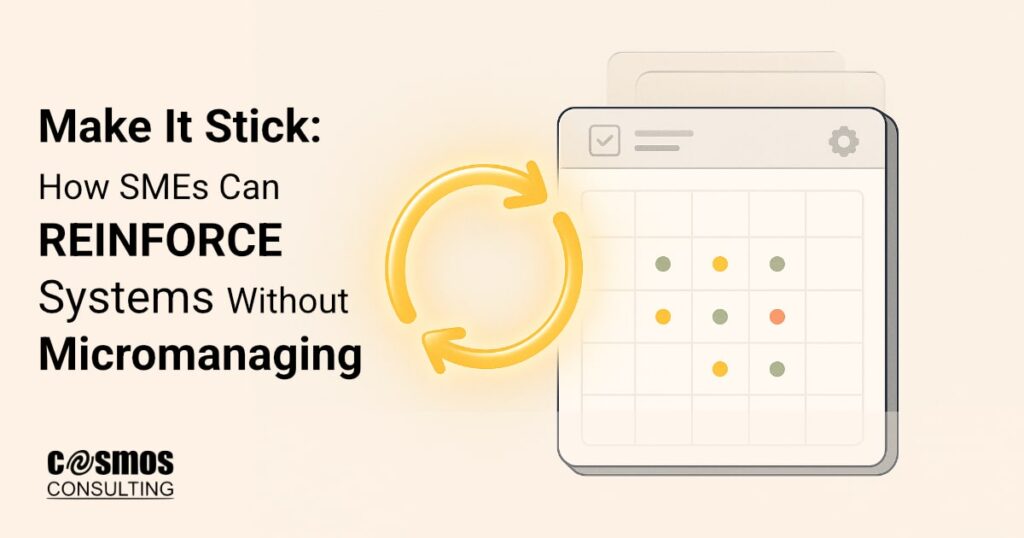
One-time fixes don’t scale. Reinforcement is what turns new habits into culture.
This “R” earned its place because many SME leaders stop just short of real change. They review, reset, even delegate well, but don’t consistently reinforce what’s working.
Whatever the format, reinforcement is how leaders turn clarity into consistency.
This is where leadership becomes habit-making. It is not the most glamorous part of the 5R Framework, but it is what makes everything else stick.
Without reinforcement, even great systems decay. Teams slip back into old habits, and leaders end up solving the same problems in new ways, over and over again.
Reinforcement can be simple:
- A team shoutout in a Monday huddle
- A KPI celebrated in the dashboard
- A habit quietly repeated, until it becomes muscle memory
Systems scale when leadership repeats what matters.
🟡 Example: If your team finally nails a weekly client follow-up rhythm, do not just acknowledge it once. Reinforce it, reference it in meetings, link it to results… this keeps the rhythm visible.
Systems scale when leadership repeats what matters.
👉 Read the deep dive: Make It Stick: How SMEs Can Reinforce Systems Without Micromanaging
✅ Reflective Takeaway (Final)
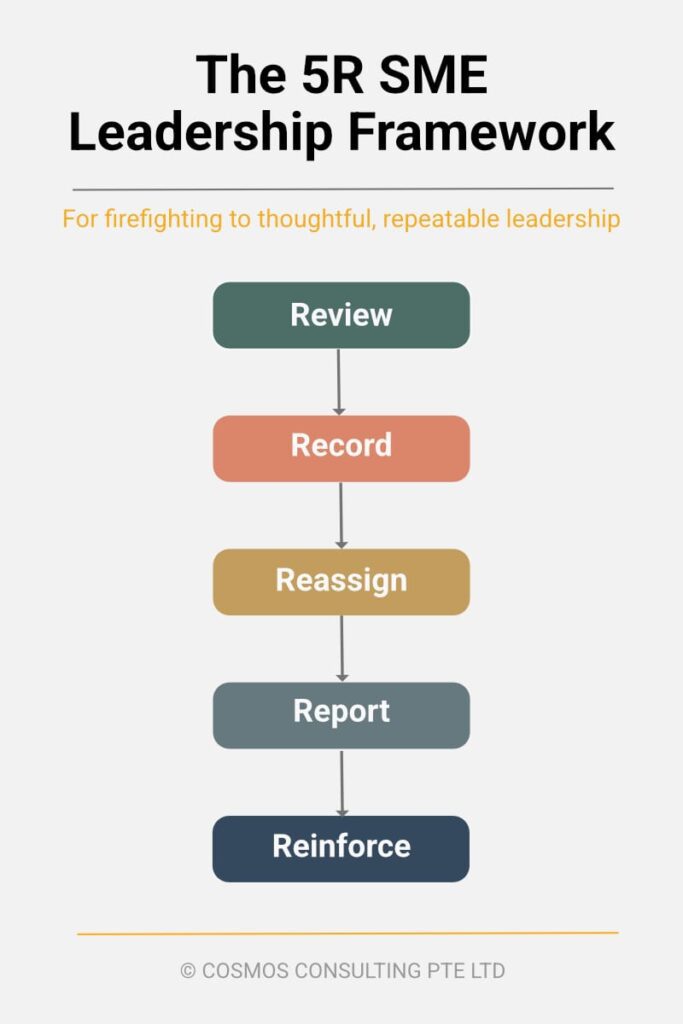
Each “R” invites SME leaders to step out of firefighting mode into a system of thoughtful, repeatable actions.
At Cosmos Consulting, we have seen it again and again: businesses that already have tools and SOPs in place, but still stall because leadership remains reactive.
The COSMOS 5R Framework exists to solve that problem not with more hustle, but with a reset: a structure that lets you delegate with confidence, lead with clarity, and finally breathe.
Because when leadership becomes a framework, not just a feeling, teams grow, founders breathe, and businesses scale with confidence.
Start with just one shift. Then another. That is how systems leadership is built… one move at a time.
❓FAQ: COSMOS 5R Leadership Framework™
Here are a few common questions SME leaders ask when implementing the COSMOS 5R Leadership Framework™, especially as they try to step back without losing visibility or control.
📥 Want to apply what you just read?
Most SME founders don’t need more tools; they need space to lead.
If you are ready to step out of daily reactivity and lead with more rhythm, the 5R SME Leadership Checklist will help you start.
It is a free, practical guide to help you self-assess your current leadership habits and spot the exact areas holding your team back.
👥 Systems would not stick if leadership is not evolving.
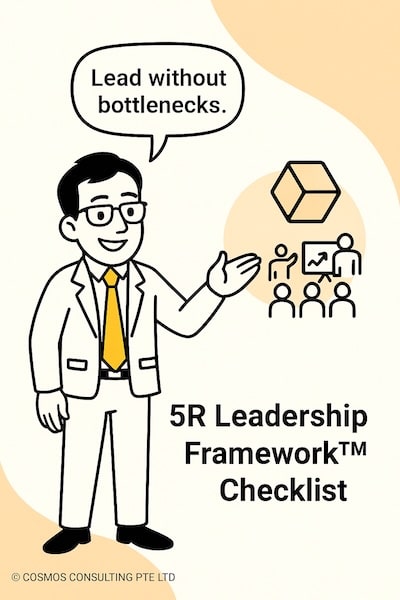
5R Checklist
A leadership self-check to prevent bottlenecks and keep your team aligned, accountable, and motivated.
Built from the 5R Framework blog
💡 We use MailerLite to power our lead magnets and client communications. It’s beginner-friendly, powerful, and highly affordable for SMEs
A practical approach for SME founders who are done with firefighting.
✅ Call to Action
Which “R” feels most urgent in your business right now?
Drop a comment below and let’s learn from each other.
Because most SME leaders are figuring this out in real time and your reflection might just unlock someone else’s next move.
We would love to hear from you.
🛡 Trademark Notice
The COSMOS 4S Systems Framework™ and COSMOS 5R Leadership Framework™ are proprietary tools developed by Chhavi Jain, Director, Cosmos Consulting. These frameworks are unregistered trademarks (™) and may not be copied, reproduced, or repurposed without explicit written permission.
© Cosmos Consulting, 2025. All rights reserved.


